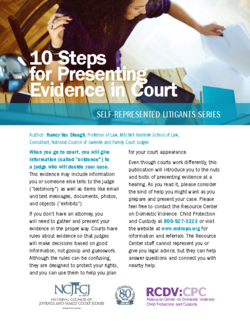10 Steps for Presenting Evidence in Court
When you go to court, you will give information (called “evidence”) to a judge who will decide your case. This evidence may include information you or someone else tells to the judge (“testimony”) as well as items like email and text messages, documents, photos, and objects (“exhibits”). If you don’t have an attorney, you will need to gather and present your evidence in the proper way. Courts have rules about evidence so that judges will make decisions based on good information, not gossip and guesswork. Although the rules can be confusing, they are designed to protect your rights, and you can use them to help you plan for your court appearance.
About RCDV:CPC
Resource Center on Domestic Violence: Child Protection and Custody.
Contact
1-800-52-PEACE or 1-800-527-3223
Email : info@rcdvcpc.org

